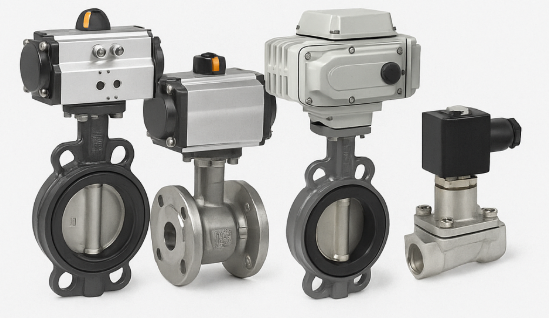Choosing the right automated valve is a crucial decision in system design. Whether you’re dealing with fluids, gases, or slurries, selecting the right actuator — electric, pneumatic, or solenoid — directly impacts performance, cost, and reliability.
This article will help you understand the differences between these actuator types, their ideal use cases, and how to make the right decision for your project.
⚡ Electric Actuated Valves
Electric valves use an electric motor to control valve position. They offer precise modulation and are ideal for remote or automated systems that don’t have compressed air.
Best for:
- Systems requiring precise control or slow operation
- Areas without compressed air supply
- HVAC, water treatment, district heating
Pros:
- Precise positioning
- Easy integration with control panels
- No air compressor required
Cons:
- Slower opening/closing time
- Sensitive to power loss
📌 Typical Product: Electric ball valve for building automation or chilled water control.
🌬️ Pneumatic Actuated Valves
Pneumatic valves use compressed air to operate and are commonly used in fast-cycling or harsh environments like chemical plants or manufacturing lines.
Best for:
- High-speed operations
- Explosive or hazardous areas
- Frequent open/close cycles
Pros:
- Fast and powerful action
- Reliable in harsh conditions
- Intrinsically safe with air
Cons:
- Requires a compressed air system
- Complex setup and maintenance
📌 Typical Product: Pneumatic knife gate valve used in slurry pipelines in mining or pulp industries.
⚡🔁 Solenoid Valves
Solenoid valves are compact, fast-acting, and electrically controlled. They are designed for simple on/off control and are ideal for small or modular systems.
Best for:
- Automated dosing
- Small flow systems
- Water, air, or neutral gas control
Pros:
- Very fast switching
- Compact and lightweight
- Cost-effective for simple tasks
Cons:
- Limited to low flow and pressure
- Can clog in dirty systems
📌 Typical Product: 2/2-way solenoid valve for irrigation control or pneumatic circuit cut-off.
🛠️ How to Choose?
Here’s a quick reference based on your application:
| Criteria | Best Choice |
|---|---|
| No compressed air available | Electric Valve |
| High-speed switching | Pneumatic Valve |
| Compact system, low flow | Solenoid Valve |
| Hazardous area (ATEX) | Pneumatic Valve |
| Precise modulation needed | Electric Valve |
| Frequent ON/OFF cycles | Pneumatic or Solenoid |
📬 Still Not Sure? We’re Here to Help.
Each system has its own challenges. Our engineering team will help you choose the right valve-actuator combination based on your pressure, media, cycle time, and environment.
👉 Contact us now to request datasheets, CAD drawings, or technical support.
📧 [Insert your inquiry form or email here]
#ElectricValves #PneumaticValves #SolenoidValves #ValveSelection #FlowAutomation #IndustrialAutomation #ProcessControl #ActuatedValves #EngineeringSupport #FluidHandlingSolutions


